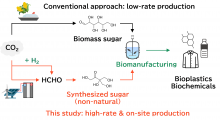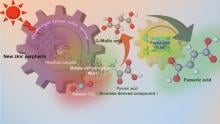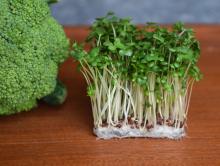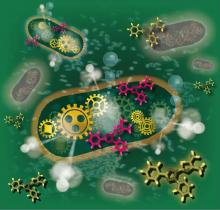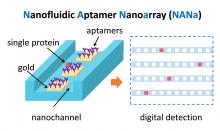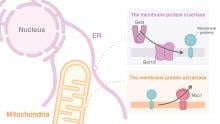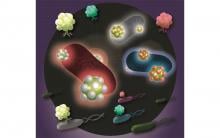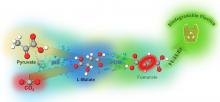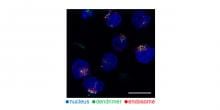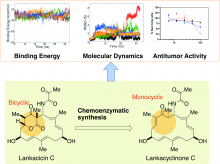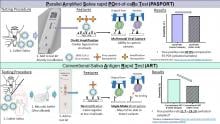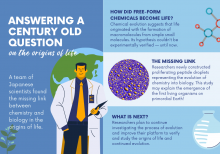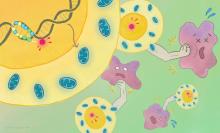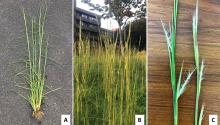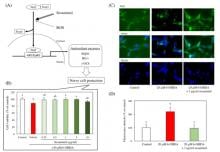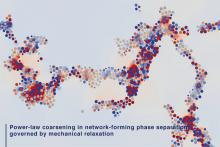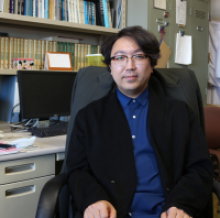Chemistry Biochemistry
News
28 Feb 2024
A new user-friendly tool helps researchers explore how gene activity is influenced by chemical modifications, providing insights into disease and paths to new treatments.
14 Feb 2024
Researchers from Osaka University and collaborating partners succeeded in biomanufacturing from chemically synthesized sugar for the first time in the world. With refinement of this technology, one can envision a future society in which the sugar required for biomanufacturing can be obtained "anytime, anywhere, and at high rate". In the future, biomanufacturing using chemically synthesized sugar is expected to be a game changer in the biotechnology field—including the production of biochemicals, biofuels, and food, where sugar is an essential raw material—ultimately leading to the creation of a new bio-industry.
14 Feb 2024
An innovative and more efficient way to produce fumaric acid that not only reduces carbon dioxide emissions, but also reuses waste resources to make biodegradable plastics
27 Oct 2023
- This team developed the PAINT technology that controls the adhesive properties of new organic materials, analyzes melanin formation processes, and facilitates selective melanin formation.
- A research paper on the technology, which fabricates local patterns based on melanin-like pigments, was published in Nature Communications, an international academic journal.
20 Oct 2023
A research team from Osaka Metropolitan University has found that polysulfides are abundant in broccoli sprouts. They found that the amount of polysulfides increased dramatically during growth, by an approximately 20-fold in seeds by the fifth day of germination. Furthermore, a comprehensive analysis of the polysulfides detected a number of polysulfide candidates whose structures have not yet been determined. The identification of these unknown polysulfides and detailed analysis of their pharmacological activities are expected to enable the development of new preventive and therapeutic strategies and medicines for cancer, neurodegenerative diseases, stroke, inflammation, and other diseases.
11 Sep 2023
Researchers at Osaka Metropolitan University have developed a measurement technique that rapidly measures the number of viable bacteria in food products. They have succeeded in drastically reducing the inspection time from 2 days to about 1 hour. With this technology, it will be possible to confirm food safety before shipment from factories and prevent food poisoning.
28 Jun 2023
Researchers from Osaka University have revealed the mechanism by which increased signaling through a pathway associated with a molecule called Wnt leads to the development of liver cancer. They identified a gene called GREB1 as a target of Wnt specifically in liver cancer. This gene alters the function of a protein called HNF4α, leading to the development of cancer. They also showed that treatment of mice with antisense oligonucleotides against GREB1 had significant anti-cancer effects.
23 Jun 2023
An international team led by Professor Yan Xu from Osaka Metropolitan University has developed a groundbreaking nanofluidic device, named NANa, capable of stochastically capturing and digitally detecting individual proteins at cellular concentrations. This tool, vital for precision medicine, is designed to handle tiny volumes equivalent to a single cell's contents and can identify single biomolecules even in high-concentration environments. The team plans to conduct further demonstrations using actual cell samples and explore the integration of this tool with AI and biological big data. This research could potentially revolutionize personalized disease prevention and treatment.
13 Apr 2023
A research group at Osaka Metropolitan University has succeeded in selectively recovering trace rare earth elements in synthetic seawater and environmental water, such as hot spring water, using baker’s yeast with a phosphate group added. The phosphorylated yeast is expected to be utilized as a material for recovering useful metals and removing toxic metals, thereby contributing to the realization of a metal resource-circulating society.
10 Mar 2023
Osaka Metropolitan University scientists successfully quantified the total reactive polysulfide content of 22 different types of vegetables, including onions and garlic. They also revealed that reactive polysulfides are not only found in the leek genus (Allium), such as onions and garlic but also in the cruciferous family of vegetables (Brassicaceae), such as broccoli and cabbage.
31 Jan 2023
Researchers from Osaka University have shown that a system known as the GET pathway is essential for efficient mitophagy, the process by which mitochondria are removed from cells. The GET pathway targets a protein assembly called the Ppg1–Far complex, which inhibits mitophagy, to the membrane of a part of the cell called the endoplasmic reticulum. When the GET pathway is defective, this complex instead becomes targeted to mitochondria, where it acts to suppress mitophagy.
24 Jan 2023
Osaka Metropolitan University scientists have succeeded in synthesizing fumaric acid, a raw material for plastics, from CO2 powered by solar energy—for the first time. Typically, fumaric acid is synthesized from petroleum as a raw material to make polybutylene succinate, a biodegradable plastic, but this research shows that it can be synthesized from CO2 and biomass-derived compounds using renewable energy.
03 Nov 2022
Researchers from Osaka University have demonstrated a proof-of-concept for a novel use of artificial intelligence for enzyme engineering that does not require an enzyme’s crystal structure. By analyzing the amino acid sequences of malic enzymes from various living organisms, the researchers identified the amino acids that are pertinent to using different redox cofactors. The results of this work will facilitate retooling enzymes in research laboratories and the biotech industry.
29 Sep 2022
Linked lanthanides shine light on crystal engineering, New technique reveals hidden genome, Red, white and blue alerts for dangerous bacteria & Windows gain competitive edge over global warming. Read all in the September's Editor's Choice plus this month's Asia Research News 2022 magazine pick - Floating sensors to gather ocean data.
29 Aug 2022
Osaka Metropolitan University scientists developed a simple, rapid method for identifying food poisoning-inducing bacteria based on color differences in the scattered light of composite structures consisting of gold, silver, and copper nanoparticles and polymer particles. Using these composites as test labels bound to specific bacteria, the researchers detected food poisoning bacteria E. coli O26, E. coli O157, and S. aureus as white, red, and blue scattered light, respectively, under the microscope. This new method enables simultaneous identification of multiple bacterial species within one hour, significantly shortening the usual 48-hour time requirement for conventional bacterial tests.
23 Aug 2022
Two new approaches could help scientists use existing sequencing technology to better-distinguish RNA changes that affect how their genetic code is read.
22 Aug 2022
Osaka Metropolitan University researchers have successfully synthesized fumarate (fumaric acid), a raw material for unsaturated polyester resin, by combining carbon dioxide (CO2) with pyruvate (derived from biomass), using two biocatalysts: malate dehydrogenase and fumarase. Fumarate is currently used to make biodegradable plastic like polybutylene succinate from petroleum. However, this research has enabled the synthesis of fumarate without petroleum, consuming only CO2 and biomass-derived pyruvate.
02 Jun 2022
Giants in History: Known for her pioneering contributions to bio-organic chemistry, Darshan Ranganathan (4 June 1941 – 4 June 2001) is considered India’s most prolific chemist.
16 Feb 2022
This is a novel study that attempted to construct a pH-sensitive delivery system into T cells and their subsets using carboxy-terminal Phe- and CHex-modified dendrimers with different structures, i.e. PAMAM-CHex-Phe and PAMAM-Phe-CHex. The findings contribute to the development of nanoplatforms for direct delivery to T cells to control the functions of T cells, which play key roles in cancer immunotherapy. This is the first report on direct delivery into T cells using pH-sensitive DDS.
31 Jan 2022
Garden soil houses a variety of bacteria and their natural byproducts — including one that may help halt tumor growth. Lankacidins are molecules that can be isolated from Strepomyces rochei, a common bacterium in soil. In addition to antimicrobial properties, a type of lankacidins, called lankacidin C, can inhibit tumor activity in various cancer cell lines, including leukemia, melanoma, ovarian and breast cancers. Lankacidin C offers a potential foundation on which to design anticancer drugs, but its structure is complicated and difficult to manipulate, according to an international research group. The same group recently identified where antitumor activity is housed on the molecule and has now used that information to simplify lankacidin as a potential starting point to engineer treatments.
08 Dec 2021
A new saliva-based COVID-19 Antigen Rapid Test (ART) technology co-developed by the SingHealth Duke-NUS Academic Medical Centre and the National University of Singapore shows promise in early clinical testing, outperforming existing ARTs and delivering results in minutes, with nearly comparable sensitivity to the gold standard Polymerase Chain Reaction (PCR) test.
02 Nov 2021
Researchers from The University of Tokyo Institute of Industrial Science use optical microscopy to form a picture of what’s really going on inside surfactant onions
01 Oct 2021
Paris, 29 September — UNESCO and the L'Oréal Foundation are unveiling the winners of this year’s International Prize for Women in Science, which honours five eminent women scientists with exceptional careers from the five regions of the world, as it has done annually since 1998.
27 Sep 2021
The missing link isn’t a not-yet-discovered fossil, after all. It’s a tiny, self-replicating globule called a coacervate droplet, developed by two researchers in Japan to represent the evolution of chemistry into biology.
13 Sep 2021
iCeMS scientists and colleagues have designed a molecular code that powers up cancer-fighting immune cells.
17 Mar 2021
Researchers improve their newly established quantum algorithm, bringing it to one-tenth the computational cost of Quantum Phase Estimation, and use it to directly calculate the vertical ionization energies of light atoms and molecules such as CO, O2, CN, F2, H2O, NH3 within 0.1 electron volts of precision.
05 Mar 2021
An international team of researchers has found that A. virginicus extracts appear to be effective against several human diseases, including diabetes and cancer. The results were published on Dec. 31, 2020, in a special issue of Plants, titled “Biological Activities of Plant Extracts.”
03 Mar 2021
Osaka City University finds that the chemical sesaminol, naturally occurring in sesame seeds, protects against Parkinson’s disease by preventing neuronal damage that decreases the production of dopamine. In vitro experiments show sesaminol handle oxidative stress in cells by regulating the production of reactive oxygen species and the movement of antioxidants. In vivo experiments reveal that a diet of sesaminol increases production of dopamine and significantly improve motor functions in mice.
10 Feb 2021
Researchers at The University of Tokyo discover a new law about how the complex network of phase-separated structures grows with time, which may lead to more efficient batteries and industrial catalysts
Events
Sorry, nothing coming up for this discipline
Researchers
Prof. Muneyuki Matsuo is an Assistant Professor at the Department of Chemistry, School of Science / Program of Mathematical and Life Sciences, Graduate School of Integrated Sciences for Life, Hiroshima University
Carla Portugal is currently an Assistant Researcher at LAQV-Requimte, NOVA.iD.FCT and is experienced in the development, implementation and monitoring of membrane based processes.
Tony Z. Jia is a researcher at Japan’s Earth-Life Science Institute (ELSI), based at the Tokyo Institute of Technology. His research focuses on astrobiology, prebiotic chemistry, and origins of life.
I do research on dysmennorrhoea and gender-based violence. I am a pioneer in registered clinical trials on indigenous and Ayurveda medicines in Sri Lanka. I have approval for a herbal preparation, for COVID patients.
Dr.Ms.Aruna Dhathathreyan is a professor and emeritus scientist at the Advanced Materials Lab, CSIR-Central Leather Research Institute, India.
Dr. Mashura Shammi is an associate professor at the Department of Environmental Sciences, Jahangirnagar University, Bangladesh.
Giants in history
Sorry, nothing coming up for this discipline




